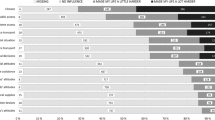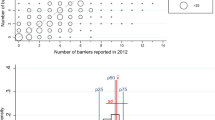Abstract
Study design
Qualitative exploratory study.
Objectives
To understand the lived experiences of individuals with spinal cord injuries or disorders (SCI/D) who use wheelchairs during air travel in the United States (US), with a focus on the challenges and barriers to accessing this form of transportation.
Setting
Wheelchair users with SCI/D living in the community in the US.
Methods
Semi-structured interviews were used to collect data from six wheelchair users with SCI/D. Data were analyzed using a six-step thematic analysis.
Results
Experiences of wheelchair users during air travel clustered into three themes; experiences interacting with the airport, experiences interacting with the airplane, and experiences across all stages of air travel. Barriers to airport accessibility were minimal. Physical barriers to airplane accessibility and damage to wheelchairs occurred when interacting with the airplane and airline staff. Undertrained staff and a shift in responsibility to the passenger with a disability impacted all stages of the experience.
Conclusion
Wheelchair users with SCI/D encounter challenges that can result in unsafe and inaccessible air travel within the US. Adverse consequences of air travel often impact the individual’s independence and quality of life during and after the flight. Participants provided recommendations to improve the air travel experience for wheelchair users, including the ability to remain in one’s wheelchair while onboard the airplane.
This is a preview of subscription content, access via your institution
Access options
Subscribe to this journal
Receive 1 print issues and online access
We are sorry, but there is no personal subscription option available for your country.
Buy this article
- Purchase on Springer Link
- Instant access to full article PDF
Prices may be subject to local taxes which are calculated during checkout

Similar content being viewed by others
Data availability
The data generated and analyzed during the current study are not publicly available due to the possibility of identifying information being present in the qualitative data. Datasets may be made available through direct requests to the corresponding author of this article.
References
Stanley JK, Hensher DA, Stanley JR, Vella-Brodrick D. Mobility, social exclusion and well-being: Exploring the links. Transp Res Part A Policy Pract. 2011;45:789–801.
Yau MK, McKercher B, Packer TL. Traveling with a disability: More than an access issue. Ann Tour Res. 2004;31:946–60.
Velho R. Transport accessibility for wheelchair users: A qualitative analysis of inclusion and health. Int J Transp Sci Technol. 2019;8:103–15.
Paralyzed Veterans of America. The ACAA survey: Overview of survey results regarding the air travel experiences of passengers with disabilities. 2022. https://pva.org/wp-content/uploads/2022/09/2022-ACAA-Survey-Results-FINAL.pdf.
Darcy S. Flying with impairments: Improving airline practices by understanding the experiences of people with disabilities. Travel and Tourism Research Association: Advancing Tourism Research Globally. 2016;47. https://scholarworks.umass.edu/ttra/2007/Presented_Papers/47. Accessed 24 Oct 2023.
Davies A, Christie N. An exploratory study of the experiences of wheelchair users as aircraft passengers–implications for policy and practice. IATSS Res. 2017;41:89–93.
Poria Y, Reichel A, Brandt Y. The flight experiences of people with disabilities: an exploratory study. J Travel Res. 2010;49:216–27.
Saari S. Taking over the world in a wheelchair: The difficulties and challenges when travelling by air transportation. 2015. https://www.theseus.fi/handle/10024/96592. Accessed 24 Oct 2023.
Chang Y-C, Chen C-F. Meeting the needs of disabled air passengers: Factors that facilitate help from airlines and airports. Tour Manag. 2012;33:529–36.
Americans with Disabilities Act of 1990, Pub. L. No. 101-336, 104 Stat. 327 Stat. 328. 1990. https://www.congress.gov/101/statute/STATUTE-104/STATUTE-104-Pg327.pdf.
Air Carrier Access Act of 1986, Pub. L. No. 99-435, 100 Stat. 1080 Stat. 1080. 1986. https://www.congress.gov/99/statute/STATUTE-100/STATUTE-100-Pg1080.pdf.
Major WL, Hubbard SM. An examination of disability-related complaints in the United States commercial aviation sector. J Air Transp Manag. 2019;78:43–53.
Saunders B, Sim J, Kingstone T, Baker S, Waterfield J, Bartlam B, et al. Saturation in qualitative research: exploring its conceptualization and operationalization. Qual Quant. 2018;52:1893–907.
Tracy SJ. Qualitative research methods. Chichester: Wiley-Blackwell; 2013.
Braun V, Clarke V. Using thematic analysis in psychology. Qual Res Psychol. 2006;3:77–101.
United States Department of Transportation. Air travel consumer report. 2023. https://www.transportation.gov/sites/dot.gov/files/2023-04/February%202023%20ATCR_Revised.pdf.
Toro ML, Worobey L, Boninger ML, Cooper RA, Pearlman J. Type and frequency of reported wheelchair repairs and related adverse consequences among people with spinal cord injury. Arch Phys Med Rehabil. 2016;97:1753–60.
Saghaleini SH, Dehghan K, Shadvar K, Sanaie S, Mahmoodpoor A, Ostadi Z. Pressure ulcer and nutrition. Indian J Crit Care Med. 2018;22:283.
National Spinal Cord Injury Statistical Center. Facts and Figures at a Glance. Birmingham, AL: University of Alabama at Birmingham; 2016.
Acknowledgements
The authors thank the participants for their time and willingness to provide invaluable insights into this topic.
Author information
Authors and Affiliations
Contributions
JLP was responsible for designing the study protocol, recruiting participants, collecting and analyzing data, interpreting results, and writing, revising, and finalizing the manuscript. WB was responsible for recruiting participants and collecting and analyzing data. He contributed to the study design, interpreting results, and revising and finalizing the manuscript. PR provided feedback on the study design, giving methodological support, and co-writing the final report of the results.
Corresponding author
Ethics declarations
Competing interests
The authors declare no competing interests.
Ethics approval
This study was approved by the University of Kentucky Institutional Review Board. All participants provided written informed consent.
Additional information
Publisher’s note Springer Nature remains neutral with regard to jurisdictional claims in published maps and institutional affiliations.
Supplementary information
Rights and permissions
Springer Nature or its licensor (e.g. a society or other partner) holds exclusive rights to this article under a publishing agreement with the author(s) or other rightsholder(s); author self-archiving of the accepted manuscript version of this article is solely governed by the terms of such publishing agreement and applicable law.
About this article
Cite this article
Pfeiffer, J.L., Bower, W. & Rumrill, P. Investigating the challenges of air travel in the United States: a qualitative study of the lived experiences of wheelchair users with spinal cord injury or disorder. Spinal Cord Ser Cases 10, 25 (2024). https://doi.org/10.1038/s41394-024-00641-6
Received:
Revised:
Accepted:
Published:
DOI: https://doi.org/10.1038/s41394-024-00641-6



